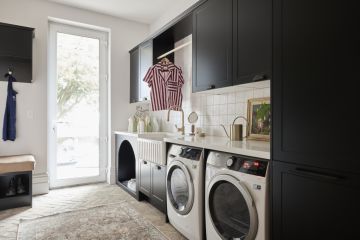'Architects have got to get the message out': Janet Holmes a Court on why architecture is an art

For the past 16 gatherings of the august Venice Biennale, architecture, the discipline that requires hard maths and often hard hats, has been fittingly incorporated within the broader fine arts family.
This was a welcome reunion because as a commercial calling, architecture had long been perceived as the orphan child of the arts – sometimes adopted when a building was judged sublime, just as often relegated to the pragmatic disciplines like engineering.
Since returning to the fold in 1980, on an ongoing basis and in the beautiful setting of the Giardini parklands and the historic Venice Arsenal, the chosen architects who represent 60 or so nations that take part in the Biennale Architettura have had an international forum in which to show what they can do when operating from a more conceptual basis than usual.
At Venice, we get to see architects as artists. We and the thousands of other professionals and interested visitors get to ascertain what they’re capable of when authoring projects that don’t need to stand up for 100 years, just for the May-November duration of the Biennale in order to provoke, allude to revolutionary directions, inspire and/or distil deep insights.
Staged within the national pavilions, the presentations are also expected to reflect something unique about their country of origin.
For this year’s gathering, which has the overall theme of “freespace”, the Melbourne partnership of Baracco + Wright Architects has selected as their subject, “repair”, which has given them scope to articulate one of their dearest and most often demonstrated theories.
According to the Italian-trained Associate Professor Mauro Baracco, who for many years has been Deputy Dean at RMIT, one of Australia’s leading architecture and urban design faculties, “we believe it is the role of architecture to actively engage with the repair of the places it is a part of, the soil, hydrology, habitat, connections, overland water flow, micro-organisms, vegetation and so on”.
For their exhibit, and in league with an Australian team who include an urban designer, an ecologist, landscape architect and the artist Linda Tegg, Baracco + Wright are raising from 30,000 seeds in Italy some 65 species of grasses indigenous to the western plains of Victoria.
- Related: Rare table could fetch $2m at auction
- Related: The academy that is modern Tasi architecture
- Related: Surry Hills’ hidden garden oasis
On the ground, only one per cent of this native grassland type remains.
What the architects hope is that their “repair” installation will accelerate an essential discussion and maybe even prompt “a shift in thinking among built-environment disciplines towards repairing …”
Yes, but grass? It’s a deceptively simple idea with profound implications by begging the question: “how can architecture play a role in repairing the places it is part of?”
While the architects and their colleagues are 2018 team Australia, returning to the role of Commissioner for the fourth time since 2008 is advocate-in-chief, Janet Holmes a Court, who is more than happy to champion architects and architecture in any scenario.
The 75-year-old businesswoman, art collector and patron of more causes than most people could conceive, Holmes a Court is a fan and thinks architects should bang their own drums much more loudly because, for one thing she happens to be the great granddaughter of Richard Roach Jewell, WA’s only qualified architect from the 1850s-’80s.
She also believes architectural involvement in our built environment “is always important because you always get better buildings”.
She says that while internationally “there are a remarkable number of Australian architects doing great work”, she is concerned that on too many local projects these “daring creatives” are thwarted by “having to deal with accountants who say ‘sorry, we can’t afford that’.”
While Holmes a Court is happy to play the commissioner role “probably until I die”, and to fly around the country making speeches on behalf of major sponsors like Austral Bricks who largely finance the requisite $750,000 it takes to get the team to the pavilion and to stage the exhibition, she also believes Australian architects should learn the art of self promotion.
“Architects have got to get the message out more strongly that to build a house without them, to build a building without them, is usually disappointing. We’ve got to have more respect and understanding of how important architecture is because, in the long run, architect-designed buildings are always going to be more environmentally friendly.”
We recommend
States
Capital Cities
Capital Cities - Rentals
Popular Areas
Allhomes
More







